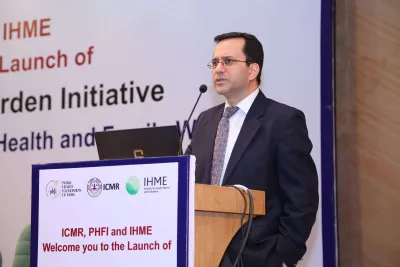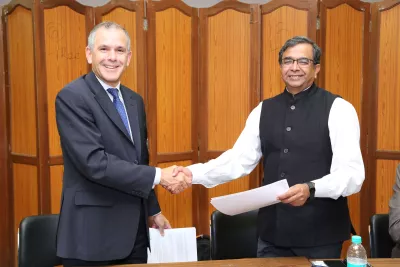Indian Council of Medical Research champions state-level disease burden project
Published October 15, 2015
Many of India’s 29 states are larger than most of the world’s countries. Uttar Pradesh alone, for example, has as many people as Brazil: 200 million.
But this country within a country can be hidden by the other 1 billion people in India. That means that the health challenges of different parts of India can be hidden by the overall health trends at the national level.
To help reveal those differences within the country, the Indian Council of Medical Research (ICMR) – the country’s leading research arm – along with the Public Health Foundation of India (PHFI) and the Institute for Health Metrics and Evaluation (IHME) at the University of Washington launched an innovative project this month: a state-level assessment of health loss in India.
“This is an opportunity to gain a lot of new information for helping our health policy priority setting and also to build the capacity of some of our young and mid-career scientists so that a few years from now we can take the lead on this kind of exercise within the country,” Dr. Soumya Swaminathan, the Director General for ICMR, told a standing room only crowd in Delhi.
IHME, PHFI, and ICMR will work together over the next few years to provide a disease burden analysis, by age and gender, over time, for hundreds of diseases, injuries, and risk factors for each of India’s 29 states. The initiative continues a trend started with subnational analyses of disease burden in the United Kingdom, China, and Mexico, based on the methods of the Global Burden of Disease (GBD) study. A collaboration among more than 1,400 collaborators from 114 countries, GBD is the largest and most comprehensive effort to date to measure epidemiological trends worldwide.
“The feedback from those countries is that the subnational burden of disease has been extremely useful for the governments for policy planning, for resource allocation, and for fine-tuning their programs at the local level,” said Dr. Prasada Rao, the former Secretary of Health for India and the chair of the Joint State-level Disease Burden Initiative Management Committee.
Dr. Lalit Dandona, a Distinguished Research Professor at PHFI and Professor at IHME, noted India’s huge potential to build on its achievements in improving health since 1990. Despite a dramatic reduction in child mortality and longer life expectancies in the country, a large burden of preventable health loss remains.

Dr. Lalit Dandona discusses India’s potential for further achievements in health
“In India, 10% of all health loss happens in just the first week of life, and when you look at the span from birth to age 5, 25% of all health loss is in just those first five years,” Dr. Dandona said. “The GBD shows us that much more is possible in terms of improvement of health, and understanding this at the state level will make these findings more policy-relevant.”
One way to make the findings more policy-relevant will be incorporating the subnational estimates into IHME’s dynamic data visualization tools. So far, IHME has incorporated into the visual tools subnational disease burden estimates from Mexico, China, and the UK.
“There is nothing like the GBD for a fully integrated analysis of health information globally,” said Dr. Peter Piot, the chair of the Independent Advisory Committee to the GBD. “When I read about big data, most of the time it is fairly meaningless, except to people in marketing and advertising. But with the GBD, we’re making big data on health accessible, and it doesn’t just focus on longer life but also on better life until we die.”
Dr. Srinath Reddy, President of PHFI, said of the project, “The GBD estimates will form the GPS of good health policy.”
And like a good GPS system, the estimates will only have an impact if they are properly used.
“Our goal is to improve health by providing timely, local, and valid evidence about levels of health and how to improve them to people who are in the position to make decisions,” said Dr. Christopher Murray, IHME’s Director. “Local ownership is a critical step for the information to have the transformative impact that we so strongly believe in. So having this initiative in India is such a welcome evolution. Hopefully this is just the beginning.”

Dr. Christopher Murray and Dr. Srinath Reddy sign an official collaboration agreement
The Global Burden of Disease also helps provide an answer to broad concerns about the lack of data to estimate levels and trends in health accurately.
“Perfect data do not exist, but the great advantage of this approach is it allows integration from multiple sources of data,” Dr. Dandona said. “It provides for the best possible estimates, and it points to crucial gaps that must be addressed.”
One way to improve the quality of data going into the state-level estimates will be to incorporate more data from each state. Dr. Rao’s committee will work with representatives from India’s states to promote data sharing and capacity building.
“This is the first initiative in India to estimate disease burden in the states, and it will be extremely helpful,” said Dr. N.S. Dharmshaktu, the Additional Director General of Health Services from India’s Ministry of Health & Family Welfare. “I’m sure all the states will be very enthusiastic to participate in this process.”
Across the specialties represented at the meeting, from air pollution to child and maternal health to cardiovascular disease, the speakers urged decision-makers at all levels to engage with the disease burden initiative and make use of the findings.
“We need to use this data for changing things, and for moving and shaking things. We need to use it to reduce complacency,” said Dr. Swarup Sarkar, Director of Communicable Diseases for the World Health Organization’s Southeast Asia Regional Office. “In half the country HIV could be going up and in half HIV could be going down, but we won’t know if we only see the national-level data. Unless we use the data to allocate proportionate resources to where the burden is, we cannot change anything. We need to have course correction on a real-time basis.”
The WHO threw its support behind the project with an enthusiastic endorsement from Dr. Poonam Khetrapal Singh, WHO Regional Director for Southeast Asia.
“Other countries in the region are looking at this with a lot of excitement,” Dr. Singh said. “They are looking to see what happens in this India study so we can take it forward into other countries.”
At the end of the launch, the speakers were met by television cameras and reporters with digital recorders, eager to hear how this project would help reduce disparities across India. Stories started popping up hours later in the Calcutta Telegraph, India Today, DNA India, Zee News, The Hindu BusinessLine, The Better India, and the Deccan Herald.
Aradhna Wal at DNA India wrote:
Targeting the different disease patterns in different states, to form a more comprehensive national disease trend, the ministry has tapped into the Global Burden of Disease (GBD), a scientific study conducted in 100 countries, to “quantify the comparative magnitude of health loss due to diseases, injuries and risk factors by age, sex and geographies for specific points in time along with measures of uncertainty.”
As someone with deep experience leading India’s public health efforts and collaborating with health experts across the country, Dr. Rao was impressed by the speed with which the ICMR-PHFI-IHME collaboration came together and the spirit of joint mission reflected in the launch events.
“It’s not always the case in India that this many partners come together, to agree on a common agenda, and to have such a positive dialogue around improving health,” Dr. Rao said. “And I believe it’s because we have demonstrated clearly that there is an unmet need here for state-level disease burden work.”